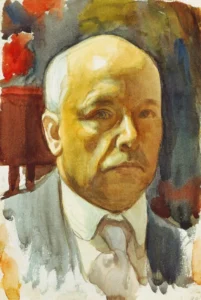Erik Nikolai Järnefelt

Self-portrait
8.11.1863, Vyborg – 15.11.1937, Helsinki
Erik Nikolai Järnefelt was born in Vyborg in November 1863 to a wealthy family and a world of opportunity. His parents were the senator and governor lieutenant August Alexander Järnefelt and Baroness Elisabeth Clodt von Jürgensburg. A circle of artists formed around the mother of the family, including figures like Minna Canth, Juhani Aho and Jean Sibelius. The young Järnefelt was surrounded by artistic geniuses of various fields from an early age.
Järnefelt graduated from Helsingin suomalainen alkeisopisto in 1881. He planned to become a schoolteacher, but due to opposition from his father he instead began to study fine arts. Järnefelt first studied art at the drawing school of the Finnish Art Society in 1874 and 1878, but it was only during his time in St Petersburg, in the years 1883–86, that his art began to mature. While studying in Paris in 1886–91, he became interested in naturalist art and in 1888 finished the paintings Ranskalainen viinikapakka and Savolaisvene. Both of Järnefelt’s parents were Fennomans. The young artist was also fascinated by the nationalist movement, and at the beginning of the 1890s nationalist art and Karelianism became his principle themes. Järnefelt first worked under a Finnish pseudonym, Eero Rauta, and later as Eero Järnefelt. Järnefelt discovered his ‘true Finland’ in Savonia, depicting its landscapes in works such as Heinäkuun päivä (1891), Raatajat rahanalaiset, also known as Kaski, (1893) and Isäntä ja rengit (1893). Of these works, Raatajat rahanalaiset in particular became a flagship of Finnish nationalist art. In addition to these larger works, Järnefelt also painted smaller nature-themed pieces and landscapes, of which many became symbols of nationalist politics.















